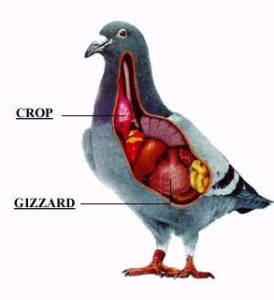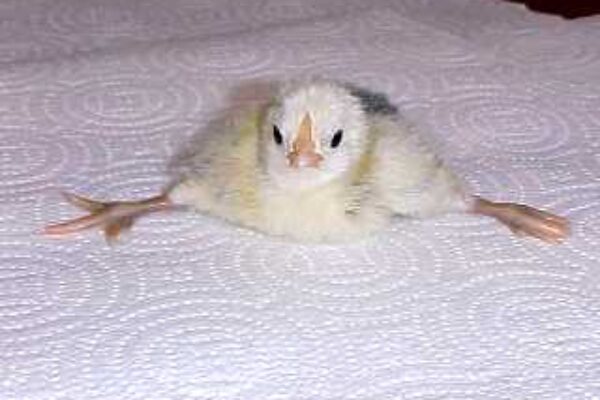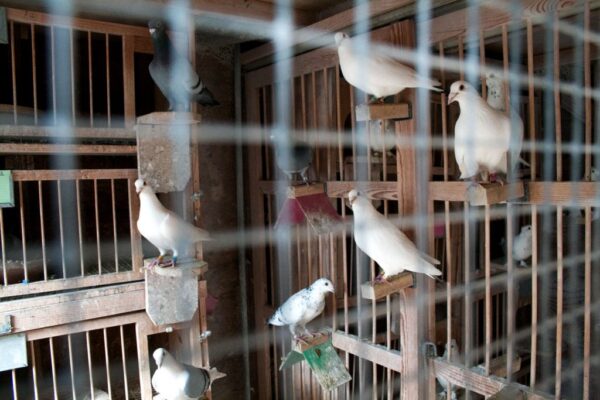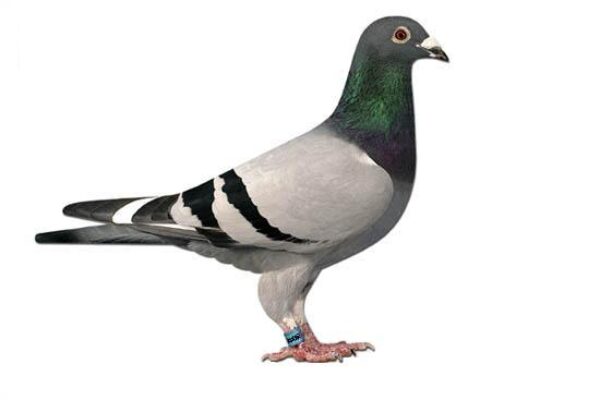Addressing the Problem of a Slow Crop in the Racing Pigeon
 A slow crop in the racing pigeon is a disorder that can not only interfere with the performance of the bird but it can also be an indicator that there is something medically wrong. In this article, we will look at the function of the crop and focus on the symptoms, causes, and treatment of a slow crop.
A slow crop in the racing pigeon is a disorder that can not only interfere with the performance of the bird but it can also be an indicator that there is something medically wrong. In this article, we will look at the function of the crop and focus on the symptoms, causes, and treatment of a slow crop.
What is a Crop?
A part of the bird’s digestive system, a crop is the dilated area at the end of the esophagus, which is the tube that extends from the bird’s throat to its stomach. The crop is a functional, contracting muscular sac.
What is the Function of the Crop?
Basically, the function of the crop is to store and prepare the food for digestion. When the bird swallows its food, the food travels down the esophagus and comes to rest in the crop. When in the crop, the food becomes moistened and softened. The crop then pushes boluses of food into the stomach, where enzymes are added and chemical digestion begins.
A Healthy Crop vs. a Slow Crop
In a healthy crop, the food passes from the crop into the stomach within twelve hours if the bird is fed twice daily and within 24 hours if the bird is fed once daily. If there is a delay in this and the food remains in the crop, this is a disorder known as a “slow crop”. Delayed crop emptying is often the first thing the fancier notices and may mean something more is wrong.
Symptoms of a Slow Crop
Often, the first time a fancier notices a problem of a slow crop in the racing pigeon is when he picks it up for a morning toss and finds there is still food in its crop from the day before. Other symptoms include the bird not being as hungry or the bird trapping sluggishly because it has food in its crop, waiting to be digested.
Causes of a Slow Crop
Basically, the main causes of a slow crop fall into four categories; problems with the feed, problems with the crop, environmental problems, and problems within the bird’s body.
Problems with Feed
The primary feed problem that can cause slow crop is contamination. Feed can become contaminated with bacteria, fungi, and toxins. When fed to the bird, the crop can become infected, irritated and inflamed.
Problems with the Crop
Infections are the primary issues here. An infection will inflame the crop and interfere with its function. Wet canker, thrush and bacterial infections such as E-coli are the most common.
Environmental Problems
Environmental problems include things such as exposure to heavy metals, like zinc or lead, lofts that fail to provide a secure and healthy environment and even fancier issues such as overtraining.
Exposure to heavy metals usually comes from drinkers, storage drums or feed trays made of galvanized metals. The exposure accumulates over time and can result not only in a slow crop but also in infertility.
Environmental issues with the loft can include things such as a cold and damp loft or an overcrowded loft. Any issue that causes stress to the bird can result in a slow crop.
Problems within the Bird
The most common problems the bird can have that may result in a slow crop are worms or Coccidia.
Diagnosing the Cause of the Slow Crop
The first thing to do when you recognize the slow crop condition is to gather a history:
- Review your recent management and handling techniques. Have you worked the bird hard in cold weather?
- Review your loft design and conditions relative to recent weather.
- Have you made any changes in the bird’s feed?
If you have ruled out the above as possible causes of a slow crop, then it is time to call the vet for assistance in diagnosing the cause. The primary method of diagnosing a slow crop is through a crop flush. Using the flush, fluid is removed from the crop and analyzed under a microscope for possible infections. Additional clinical exams to rule out causes within the bird’s body include a fecal smear to test for worms or Coccidia.
Treatment of the Slow Crop
Treatment of the slow crop includes correction of the cause. You will also want to support the bird’s health and digestion with probiotics and vitamins.
Another treatment that has proven effective is the administration of fennel tea. This was first discovered by Dr. Lorenzo Crosti, the veterinary director of the world famous bird breeding facility, Loro Parque. Dr. Crosti used fennel tea with birds exhibiting slow crops but that were otherwise healthy.
You can purchase fennel tea bags from health food stores. Brew the tea according to the directions and add it to the drinker. It smells like licorice. There is no dose ‘requirement’ for the tea. The birds will drink it readily if not mixed too strongly.








great information thanks terry
What causes a pigeon wing to lock at the joint causing it unable to flap it wing
I had that problem once with two of my birds the crop was also full of liquid and hanging and was not digesting, i squeezed out the liquid and some feed but the birds dies the next day. What can i do to solve that problem the next time it happens.
A crop filled with liquid is called SOUR CROP.
squeezing out the liquid can cause the bird to choke and will die of, essentially drowning.
using a crop needle, carefully thread the tube down the throat into the crop and suck out the liquid slowly. Then purchase 2 things, both are easy to find. Activated charcoal capsules and baking soda.
open the charcoal cap. empty one side and fill that side with the baking soda then put the ends back together (So you have a 1/2 black 1/2 white capsule.) wet the capsule in a cup of water(as the gel cap makes it impossible to swallow without it being wet)Give the pigeon 1 cap 2x a day (morning and night)and let him have all the grit and water he wants. if there is more liquid, by the time you need to dose again then suck it out with the crop needle again.
food should be limited to barley only as the fiber will help move the sediment from the charcoal/baking soda, and scrape the crop and intestines of any bacteria or blockages.
Excellent subject. How can we download and build a library of your articles? I have just restarted racing pigeons and need to brush up and check out new information available and discovered.
Paramoxivirus was discovered in South Africa when I gave up my old lofts and pigeons.
Hi Chris very good article iv’e dealt with slow crop before and fennel tea is a good thing to use
even with young bird sickness Brad.
THIS SUBJECT ABOUT A SLOW CROP AND HOW TO CURE IT WAS SOMETHING NEW TO ME.I NEVER FEEL THE CROP OF MY PIGEONS,SOMETHING TO REMEMBER IN FUTURE
I always look for the bird crop first in checking their health like full of water, delay crop emptying or empty crop otherwise I don’t mind them.
One of the main causes of slow crop emptying is canker. One something like this happens try to give the pigeon 1/4 of flagyl. Another thing is that when pigeons return from a hard race always give a light feed to re-establish the digestion system.
In diagnosing slow crop you listed “• Have you made any changes in the bird’s feed?”, but there was no detail as to what type of diet changes could cause the condition. Can you elaborate?
a great article and this slow crop thing is a lot more prevalent than we would all like to admit. And so simple to correct with a little common sense. Thanks for these articles keep them rolling always some food for thought